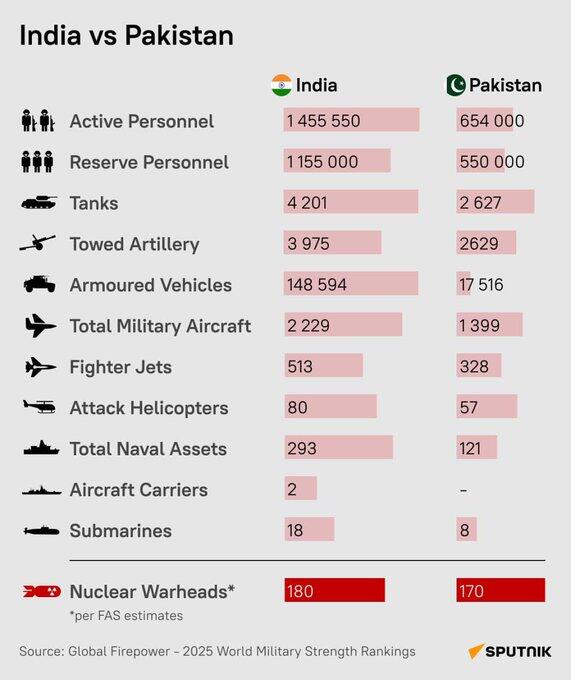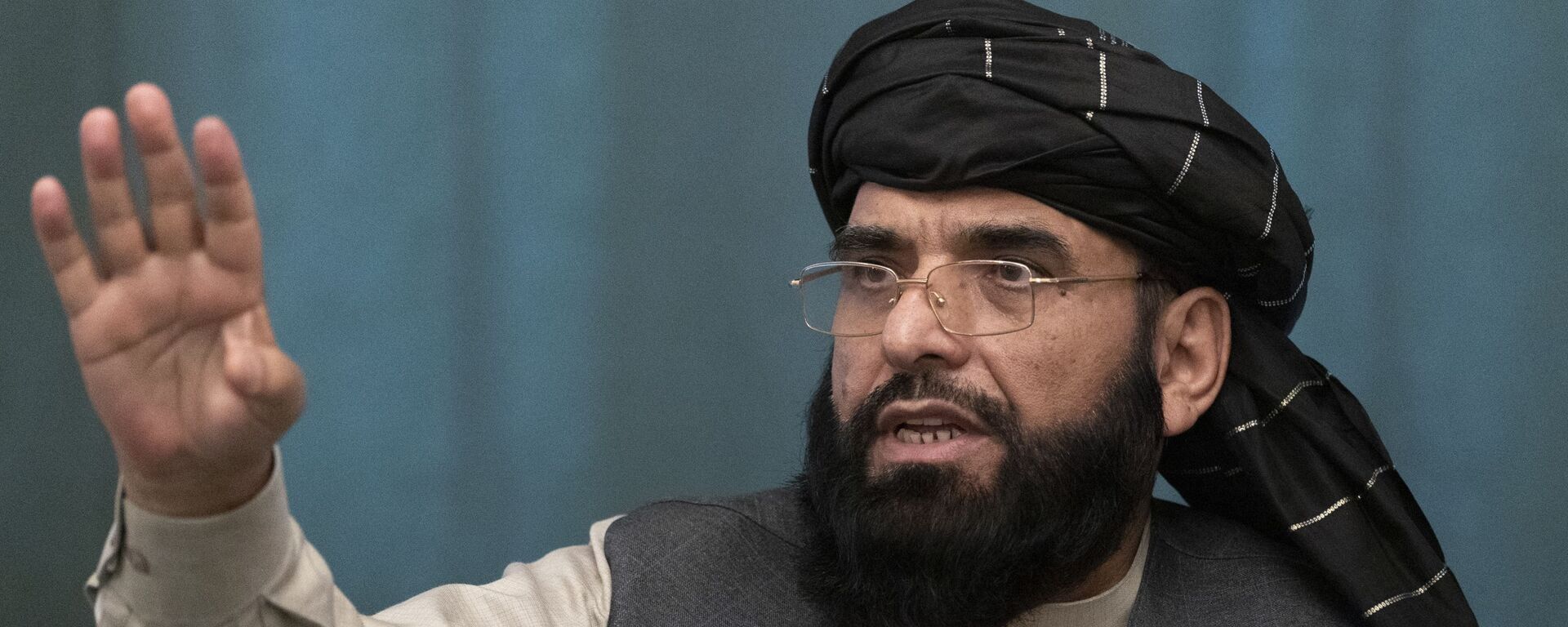https://sputniknews.in/20250426/india-vs-pakistan-military-strength-comparison-9027580.html
India vs Pakistan: Military Strength Comparison
India vs Pakistan: Military Strength Comparison
Sputnik India
Amid heightening tensions between India and Pakistan, Google searches about the military strengths of the two nations have increased manifold, with netizens... 26.04.2025, Sputnik India
2025-04-26T12:59+0530
2025-04-26T12:59+0530
2025-04-26T20:04+0530
sputnik opinion
india
pakistan
line of control (loc)
indian air force (iaf)
indian navy
indian army
delhi
new delhi
islamabad
https://cdn1.img.sputniknews.in/img/07e8/03/0c/6813527_0:114:3168:1896_1920x0_80_0_0_7bded833233fa50010796711202d8e9d.jpg
India has a substantial edge over Pakistan in terms of the number of active military personnel, fighter aircraft, naval ships, aircraft carriers, submarines, and tanks, among others.For instance, the number of active and reserve personnel in India's ranks stands at 1,455,550 and 1,155,000, respectively. In contrast, Pakistan has 654,000 individuals currently serving in its armed forces and 550,000 in its reserves.India also outnumbers Pakistan in terms of tanks, artillery guns, and armoured vehicles. At present, the world's largest democratic state operates 4,201 tanks, 3,975 towed artillery units, and 148,594 armoured vehicles.Apart from a considerable difference in their ground forces, India is way ahead of Pakistan if one scrutinizes their military aircraft stats. India has a total of 2,229 military aircraft, including 513 fighter planes and 80 attack helicopters in the Indian Air Force (IAF's contingent).Pakistan's aviation wing has 1,399 aircraft, 328 combat jets, and 57 attack choppers.India edges ahead in overall naval assets as well, with 293 ships of various types in its fleet, including frigates, missile destroyers, corvettes, submarines, and aircraft carriers. Notably, the Indian Navy has two functional aircraft carriers, namely INS Vikramaditya and INS Vikrant.Also, India holds an upper hand in underwater capacity with 18 submarines, including two SSBNs. On the other hand, Pakistan is yet to make a breakthrough in the sub-surface nuclear arena, as it doesn't have a single nuclear submarine in its arsenal.Unlike Pakistan, India's armed forces have strategic depth in terms of serving and reserve personnel. If you calculate, New Delhi has more than double the number of active and reserve troops compared to Pakistan, opines former IAF pilot, Group Captain (Retd) Uttam Kumar Devnath. Moreover, both nuclear-armed states have an almost similar number of nuclear warheads. As per the Status of World Nuclear Forces 2025 report, India holds 180 nuclear weapons, while Pakistan has 170.India's Kinetic Options to Retaliate Against PakistanTo avenge the terrorist attack in Pahalgam, India would most likely opt for an integrated response of a magnitude much higher than the strategic signalling that New Delhi did in 2016, when the Indian Army launched a trans-border special forces operation, which killed about 40 terrorists in the terror launch pads, and the 2019 airstrike in Balakot at a training camp of the Jaish-e-Mohammed (JeM), believes Major General (Retd) G. D. Bakshi.However, this time, India will not do any kind of strategic signalling and instead, will impose deterrence on Pakistan, and deterrence means that it will have to be sustained damage, it will have to hurt Pakistan's military complex, the military pundit added.India has a whole range of kinetic options, and the country's political-military leadership will not confine itself to just one or two of these options, he reckoned.All three services, the Army, Navy, and Air Force, will be involved in these operations. The Indian Navy is already exercising in the Arabian Sea, and one of its carriers has moved there. The Indian Navy also has missile destroyers, including the Kashin-class destroyers, which are in a position to punish Pakistan from the sea flank, potentially targeting Pakistan's port city of Karachi from there, the expert stated.Furthermore, the Indian Army, which has been deployed all along the LoC and international border, will exert a tremendous amount of pressure, with its first move being the revocation of the ceasefire agreement between the two sides. The ceasefire agreement came into force in 2003.Pakistan has threatened to revoke the Simla Agreement of 1972 that gave sanctity to the LoC as the de facto border between the two nations, and in such a scenario, it will be better for India to take the first step by suspending the ceasefire agreement with Pakistan. This will allow Indian troops to cross the LoC to carry out special forces raids, surgical strikes, and strategic missions across it.Meanwhile, Devnath called for a naval blockade of Pakistan's commercial shipping lanes.Pakistan has only 15 days of strategic oil reserves for emergencies, and by enforcing a naval blockade in the Arabian Sea, the Indian Navy can cripple its economy to damaging levels, the observer claimed."Pakistan knows that it cannot defeat India in a full-fledged war, especially if the conflict moves beyond two weeks, as its war reserves are only meant for two weeks, whereas India's ammunition depots can easily sustain a war for at least two months, something that cannot be ruled out", he concluded.
https://sputniknews.in/20250425/culprits-need-to-be-brought-to-justice-taliban-backs-india-slams-pahalgam-attack-9024899.html
india
pakistan
line of control (loc)
delhi
new delhi
islamabad
kashmir valley
jammu and kashmir (j&k)
Sputnik India
feedback.hindi@sputniknews.com
+74956456601
MIA „Rossiya Segodnya“
2025
Pawan Atri
https://cdn1.img.sputniknews.in/img/07e6/0c/13/139630_147:0:831:684_100x100_80_0_0_8fa2b25903e7787fe6a2698552c167df.png
Pawan Atri
https://cdn1.img.sputniknews.in/img/07e6/0c/13/139630_147:0:831:684_100x100_80_0_0_8fa2b25903e7787fe6a2698552c167df.png
News
en_IN
Sputnik India
feedback.hindi@sputniknews.com
+74956456601
MIA „Rossiya Segodnya“
Sputnik India
feedback.hindi@sputniknews.com
+74956456601
MIA „Rossiya Segodnya“
Pawan Atri
https://cdn1.img.sputniknews.in/img/07e6/0c/13/139630_147:0:831:684_100x100_80_0_0_8fa2b25903e7787fe6a2698552c167df.png
india, pakistan, line of control (loc), indian air force (iaf), indian navy, indian army, delhi, new delhi, islamabad, kashmir conflict, kashmir valley, jammu and kashmir (j&k), ins vikrant, ins vikramaditya
india, pakistan, line of control (loc), indian air force (iaf), indian navy, indian army, delhi, new delhi, islamabad, kashmir conflict, kashmir valley, jammu and kashmir (j&k), ins vikrant, ins vikramaditya
India vs Pakistan: Military Strength Comparison
12:59 26.04.2025 (Updated: 20:04 26.04.2025) Amid heightening tensions between India and Pakistan, Google searches about the military strengths of the two nations have increased manifold, with netizens looking for concrete data about how their armed forces compare with each other.
India has a substantial edge over Pakistan in terms of the number of active military personnel, fighter aircraft, naval ships, aircraft carriers, submarines, and tanks, among others.
For instance, the number of active and reserve personnel in India's ranks stands at 1,455,550 and 1,155,000, respectively. In contrast, Pakistan has 654,000 individuals currently serving in its armed forces and 550,000 in its reserves.
India also outnumbers Pakistan in terms of tanks, artillery guns, and armoured vehicles. At present, the world's largest democratic state operates 4,201 tanks, 3,975 towed artillery units, and 148,594 armoured vehicles.
Apart from a considerable difference in their ground forces, India is way ahead of Pakistan if one scrutinizes
their military aircraft stats. India has a total of 2,229 military aircraft, including 513 fighter planes and 80 attack helicopters in the Indian Air Force (IAF's contingent).
Pakistan's aviation wing has 1,399 aircraft, 328 combat jets, and 57 attack choppers.
India edges ahead in overall naval assets as well, with 293 ships of various types in its fleet, including frigates, missile destroyers, corvettes, submarines, and aircraft carriers. Notably, the Indian Navy has two functional aircraft carriers, namely INS Vikramaditya and INS Vikrant.
Also, India holds an upper hand in underwater capacity with 18 submarines, including two SSBNs. On the other hand, Pakistan is yet to make a breakthrough in the sub-surface nuclear arena, as it doesn't have a single nuclear submarine in its arsenal.
Unlike Pakistan, India's armed forces have strategic depth in terms of serving and reserve personnel. If you calculate, New Delhi has more than double the number of active and reserve troops compared to Pakistan, opines former IAF pilot, Group Captain (Retd) Uttam Kumar Devnath.
Moreover, both nuclear-armed states have an almost similar number of nuclear warheads. As per the Status of World Nuclear Forces 2025 report, India holds 180 nuclear weapons, while Pakistan has 170.
"But India is part of a select group of nations that have a nuclear triad, having operational nuclear submarines, nuclear warhead-carrying aircraft, and land-based ballistic missiles like the Agni," he elaborated.
India's Kinetic Options to Retaliate Against Pakistan
To avenge the terrorist attack in Pahalgam, India would most likely opt for an integrated response of a magnitude much higher than the strategic signalling that New Delhi did in 2016, when the Indian Army launched a trans-border special forces operation, which killed about 40 terrorists in the terror launch pads, and the 2019 airstrike in Balakot at a training camp of the Jaish-e-Mohammed (JeM), believes Major General (Retd) G. D. Bakshi.
However, this time, India will not do any kind of strategic signalling and instead, will impose deterrence on Pakistan, and deterrence means that it will have
to be sustained damage, it will have to hurt Pakistan's military complex, the military pundit added.
"It will be a clear message from India that such terror strikes will not go unpunished, and New Delhi will not confine its response to its side of the border, will not confine it to consequence management here. I reckon India will react across the Line of Control (LoC), and the international border if it has to and will exert pressure of a military kinetic kind that can deter Pakistan from such adventurism," Bakshi told Sputnik India on Friday.
India has a whole range of kinetic options, and the country's political-military leadership will not confine itself to just one or two of these options, he reckoned.
All three services, the Army, Navy, and Air Force, will be involved in these operations. The Indian Navy is already exercising in the Arabian Sea, and one of its carriers has moved there. The Indian Navy also has missile destroyers, including the Kashin-class destroyers, which
are in a position to punish Pakistan from the sea flank, potentially targeting Pakistan's port city of Karachi from there, the expert stated.
"Besides, the Indian Air Force (IAF) will be involved in a very big way, with the BrahMos supersonic cruise missiles taking the lead in any Indian counter-action, as Pakistan does not have an air defence network to intercept them," Bakshi underscored.
Furthermore, the Indian Army, which has been deployed all along the LoC and international border, will exert a tremendous amount of pressure, with its first move being the revocation of the ceasefire agreement between the two sides. The ceasefire agreement came into force in 2003.
Pakistan has threatened to revoke the Simla Agreement of 1972 that gave sanctity to the LoC as the de facto border between the two nations, and in such a scenario, it will be better for India to take the first step by suspending the ceasefire agreement with Pakistan. This will allow Indian troops to cross the LoC to carry
out special forces raids, surgical strikes, and strategic missions across it.
Meanwhile, Devnath called for a naval blockade of Pakistan's commercial shipping lanes.
Pakistan has only 15 days of strategic oil reserves for emergencies, and by enforcing a naval blockade in the Arabian Sea, the Indian Navy can cripple its economy to damaging levels, the observer claimed.
"It would not be an exaggeration to say that within a fortnight, Pakistan would be on its knees, as India can completely choke its cargo transportation routes. After all, fuel is an undeniable necessity," Devnath said in an interview with Sputnik India.
"Pakistan knows that it cannot defeat India in a full-fledged war, especially if the conflict moves beyond two weeks, as its war reserves are only meant for two weeks, whereas India's ammunition depots can easily sustain a war for at least two months, something that cannot be ruled out", he concluded.




